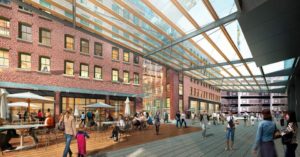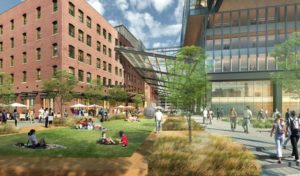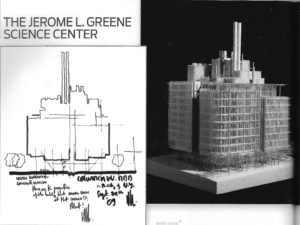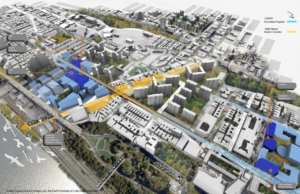Goodwill Stitched into the Urban Fabric

Late last year I wrote about GE’s new HQ, choosing new construction and renovation in Boston’s Seaport District in favor of its grassy suburban digs in Fairfield County, CT.

“We want our [new] campus to be a global epicenter of innovation, a place to foster relationships among our employees and the greater community,” said Ann R. Klee, GE’s head of Boston development and operations, in a statement.
“The 2.4-acre campus, designed by architecture firm Gensler, will open in two phases in 2018 and host 800 employees,” according to a 8/1/16 Boston Daily article.

“It will include a classroom workspace for startups, as well as university and high school students interested in STEM fields; a “convener space” for GE and community events; a co-working area for visitors; an incubator laboratory for between six and 12 early stage life science companies; and an innovation and exploration center, highlighting GE’s 124-year history.
“Plans also include an expanded, 1.5-acre Harborwalk, along with a coffee bar and ‘bistro-style restaurant’.”
The new HQ is situated in the Fort Point neighborhood of the Seaport District and borders the waterfront on one side. The lack of built infrastructure from that direction is addressed to the degree possible by a large pier and floating dock that now accommodates water taxis, boaters, public launch and boat (kiyak) rentals.
Given its immediacy to the Fort Point Channel, the buildings are designed to be resilient to sea level rise by raising the ground floors and critical operating systems in all buildings by about 4 ft., as well as through landscape design strategies such as green roofs.
From the company’s submission to the Boston Redevelopment Authority: “The GE Foundation is investing $50,000,000 in a series of initiatives to assist the Boston Public Schools, Boston area community health centers, and other area priorities.” The buildings will be LEED® certified.

Likable too is what architect Renzo Piano Building Workshop and client Columbia University have planned for the new Manhattanville campus in West Harlem (upper Manhattan).
The first structure, now nearing completion, is the 450,000 sq. ft. Jerome L. Greene Science Center. The pen-and-ink drawing immediately spoke to me about protecting the private space overhead while welcoming public activities at grade level.
“Of course, Columbia’s new buildings touch the ground, but they are public on the street level; they’re permeable, porous, and accessible,” says Piano. “There is no frontier between the buildings, the city, and the street.”
As further quoted in the Spring 2017 edition of Columbia Magazine: “… Piano says the building’s glass facade provides the scientists inspiring views of the city while enabling passersbys to observe the researchers working in their laboratories.
How is this achieved? How does the new campus project a sense of dignity and trustworthiness without being guarded?” the writer asks.
Piano’s firm, along with SOM | Architecture, has planned no gates or walls for the new campus. This contrasts with the original Morningside Heights campus, opened in 1897. (The campuses are separated by about a 10-minute walk.)
“In fact, several streets that intersect the land on which the campus is now being built will remain open to traffic.”
“Beautifully landscaped pedestrian paths will extend out into the surrounding neighborhoods, beckoning local residents into the academic sphere.” I’ll be curious to see how these actually work beyond campus boundaries.
At the Greene Science Center, which is home of the Zuckerman Mind Brain Behavior Institute, there will be an education lab where school children can learn about brain science. A wellness center there will offer free medical care to community residents.

Multiple buildings of varying academic disciplines and totaling about 6.8M sq. ft. will be built over the next few decades on the 17-acre Manhattanville campus between 125th and 133rd Sts. They’ll be LEED® certified under the Neighborhood Design rating system. Targeted for the Green Science Center is LEED® Platinum, the rating system’s highest.
What’s not to like about the approaches to integrated urban living shown in these examples by corporate and institutional leaders? They excite me as vibrant urban fabric where exchange, learning and understanding are fostered.
“Design is inherently optimistic. That is its power.” –Wm. McDonough